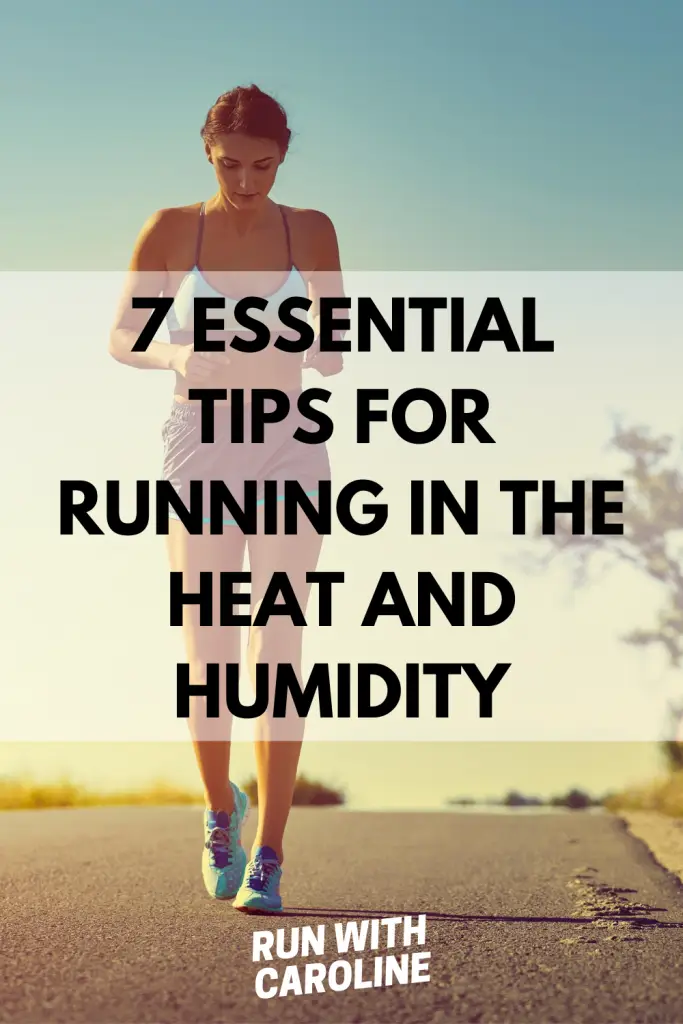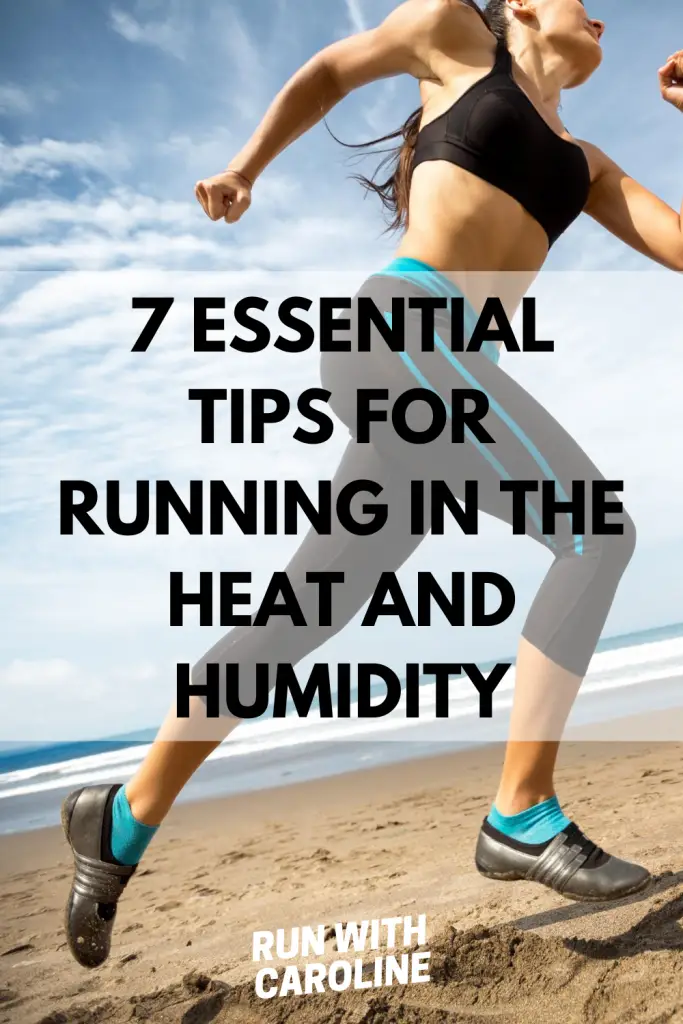Running in the heat can be dangerous if you don’t take the proper precautions.
Heat related illnesses like dehydration and heat stroke are all avoidable if you use your common sense.
As with anything, it’s better to be prepared to make things that little more comfortable.
Follow the simple tips in this guide for running in the heat and your run will hopefully be an enjoyable one!
In this article we’ll explore:
- How hot weather affects your body when running
- Benefits of running in the heat
- When to stop running in the heat
- What to wear when running in the heat
- 7 tips for running in the heat
Ready?
Let’s go!

How heat affects your body when running
Running in the heat causes physiological changes in your body.
Your body will be working in overdrive to help combat the heat. 80% of the energy generated by our muscles when running ends up as heat.
During the winter months, this heat keeps us warm, but during the summer months, the body has to get rid of it to avoid overheating.
You may notice all or some of the following changes when running in the heat:
#1 Your heart rate will be higher
When you run in the heat, your blood volume decreases meaning less oxygen is transported to your working muscles.
Your body will also direct blood to your skin to help you cool down, meaning there will be less blood available to transport oxygen to your muscles.
This will translate into lower energy levels and lower levels of efficiency, making hot weather running all the more difficult.
You may find that running at a steady pace may feel like an intense speed training session.
#2 You will find it more difficult to breathe
Your heart and lungs will be working harder because your heart rate is higher. Your breathing will become more difficult as a result.
#3 You will be sweating a lot more
Increased amounts of sweating will mean more fluid is lost which can impact performance.
Related: 11 signs and symptoms of overtraining
Benefits of running in the heat
Various studies have shown the benefits of running in the heat. In fact, when performed safely with the proper precautions, heat training can have extraordinary affects on your performance.
According to a 2010 study, athletes who regularly train in warm temperatures get better at regulating their core body temperature by sweating earlier, meaning they are able to train better in cooler temperatures.
Here are the benefits of running in the heat:
- Increased perspiration rates
- Increased blood plasma volume which leads to better cardiovascular fitness
- Reduction in blood lactate
- Increased skeletal muscle force
- Helps you withstand a wider range of temperatures
- Allows you to train better in cold temperatures
- Helps to burn more calories
Related: How to dress for winter running

When to stop running in the heat
Although nothing beats a run in the sunshine, there are signs and symptoms to look out for when running in hot weather.
If at any point you feel faint, dizzy, or your skin starts to feel cool and clammy, slow down or stop your run completely and drink some much needed fluids.
If these symptoms persist after a break, sit or lie down in the shade and seek help.
Related: Hydration and running performance
What to wear when running in the heat
There may have been times where you’ve set out for a run only to stop 10 minutes in because you’re overheating.
Make sure you wear gear that is designed for hot weather. In other words, it allows your skin to breathe.
This means prioritising light-coloured, loose and sweat wicking materials.
Polyester and lightweight Merino wool are all examples of some good sweat wicking and odour-resistant fabrics.
Stay away from cotton as, although it’s light and breathable, it’s not ideal for warm weather as it absorbs moisture and holds it next to your skin.
Chafing can also be a nightmare during summer months. Invest in some anti-chafing cream such as Bodyglide. This can be a lifesaver during the hot weather running.
Related: 7 best websites to buy affordable running gear

7 tips for running in the heat
#1 Run by ‘feel‘
Running by perceived exertion instead of pace, also known as running by ‘feel’, is a way to to measure the level of intensity of a run.
This method relies upon how hard you feel your body is working at any given time. Essentially, when you run by ‘feel’, you become more in tune with your body.
Physical sensations like your heart rate, sweat rate, breathing rate and muscle fatigue become more apparent, making it easier to know when to push harder and when to slow it down.
This is important when running in the heat because hot and humid running increases your heart rate, and knowing when to slow it down is essential to avoid dehydration and other heat related illnesses.
#2 Wear sunscreen
Do not underestimate the importance of sunscreen during the summer months.
I personally wear sunscreen every single day during the summer when I’m running and out and about.
It’s important that you protect yourself from sun damage by using a quality sunscreen before every run.
There are lots of sweat proof sunscreens on the market nowadays for runners and outdoor enthusiasts.
Brands like Coppertone, Think Sport and Blue Lizard all offer their versions. Trust me, you do not want sunscreen and sweat in your eyes when you’re running!
Be sure to choose sunscreen that has an SPF of 30 or higher for any extended outdoor activity.
If you have sensitive skin, it may also be worth checking if the cream has been dermatologically tested aswell.
#3 Wear a baseball cap and sunglasses
Protect your skin even further by wearing a baseball cap. This will not only protect your skin, but it will also help to keep your face shaded.
You may also want to consider wearing a pair of sunglasses to protect your eyes.
Sometimes running in the sun is too uncomfortable without a good pair of sunglasses – all that squinting can give you a headache.
A normal pair of sunglasses may not cut it, so consider investing in a pair of wraparound sunglasses designed for outdoor activity.
This way they won’t be sliding off your face or jumping up and down when you run.
#4 Slow it down
As I mentioned earlier, running in the heat and humidity means an easy pace run may feel that much harder.
Your body is working harder to keep your body cool.
Don’t be tempted to go all out from the beginning. Start slow, maintain a steady pace, the end slow. Your body will thank you for it!
Warm up prior to your run by doing some dynamic stretches. This is a great way to gradually increase your heart rate rather than starting out too fast.
At the end of your run, do a gradual cool down. This means finding some time for a slow walk or jog to help lower your heart rate and cool down your body, followed by some static stretches.
#5 Run early or late in the day
Schedule your runs early in the morning to avoid the midday and afternoon heat.
If you’re not a big fan of morning runs, consider doing them in the evening when it is a bit cooler.
Try to avoid running between 12-4pm as this is when the sun is at its strongest.
The heat and humidity will be high making for an uncomfortable and sweaty run.
#6 Stay hydrated
Running during the summer months means increased sweating, so you need to be replacing all the sweat lost on your runs.
If you are running for more than 75 minutes, consider taking a hand-held water bottle or hydration pack with you on your run.
If you don’t like carrying water with you, plan your route along some accessible water stops.
As a rule of thumb, you want to be consuming about 25 ounces (roughly 730ml) of fluid per hour that you’re running.
To make this easier, use a water bottle that shows measurements on the side so you know exactly how much you’re drinking.
But be careful as drinking too much water can lead to overhydration, which dilutes your electrolytes.
To combat this, drink an electrolyte sports drink in addition to water to balance out your body’s needs as you run.
#7 Head for the trails
If you regularly run in urban areas, then now might be the time to hit the trails.
When the temperatures soar, asphalt and concrete absorb heat and radiate it back into your face.
According to the US Environmental Protection Agency, cities of a million or more people can be 1 to 3 degrees warmer on average than rural areas, and as much as 12 degrees warming in the evening.
Trail running offers shade from trees and it also forces you to slow down. You may also come across a lake or river on your run which you can use to cool off.
Other useful resources
- The Mother Runners has a really useful article on running in the heat.
- 5 things I wish I’d known before returning to running - March 3, 2024
- Running 20 minutes a day: Benefits + how to start - January 27, 2024
- How to run your first 2 hour half marathon - January 16, 2024
